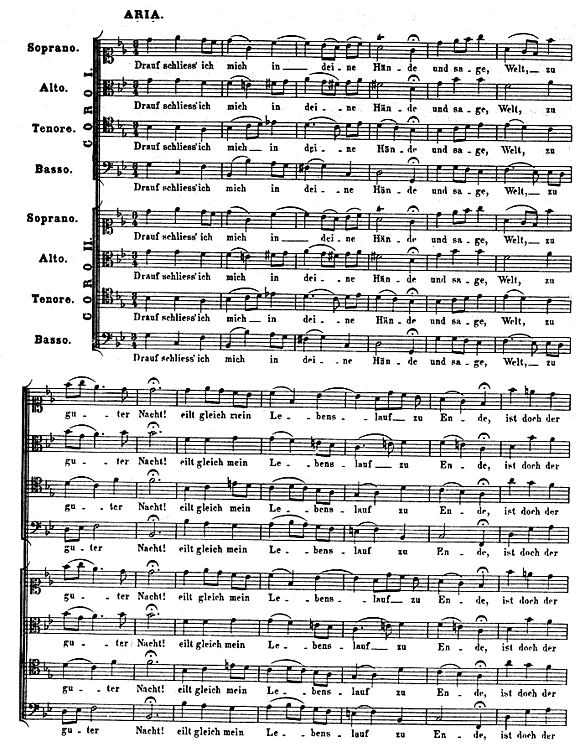This work is the one exception regarding the source of the motet text: Komm, Jesu, komm is a setting of hymnbook poetry by Paul Thymich. The text appeared in the Leipziger Gesangbuch of 1697:
| Komm, Jesu, komm, mein Leib ist müde, Die Kraft verschwindt je mehr und mehr, Ich sehne mich nach deinem Frieden; Der saure Weg wird mir zu schwer. Komm, komm, ich will mich dir ergeben, Du bist der rechte Weg, Die Wahrheit und das Leben. Drauf schliess ich mich in deine Hände Und sage, Welt, zu gutter Nacht! Eilt gleich mein Lebenslauf zu Ende, Ist doch der Geist wohl angebracht, Er soll bei senem Schöpher schweben, Weil Jesus ist und bleibt Der wahre Weg zum Leben. |
Come, Jesus, come, my flesh is weary, My strength deserts me more and more, I yearn for Thy peace; Life’s bitter journey is too hard for me. Come, I will give myself to Thee, Thou art the sure Way, The Truth and the Life. Thus I yield myself into Thy hands, And bid the world good night. Soon as my life may end, My soul is prepared. It shall rise up with its Creator, For Jesus is, and remains, The true way to Life. |
Note that the first stanza of poetry ends with a famous quote from the Gospel of John, 14:6 (I am the way, the truth and the life). The text was originally written in 1684 for the funeral of Jacob Thomasius, rector of the Thomasschule, and set to music by one of Bach’s predecessors in Leipzig, Johann Schelle. The original text contains many more stanzas, but Bach chose to use only the first and last (for reasons which are not clear).
Like Der Geist and Ich lasse Dich nicht, Komm, Jesu, komm is a double-chorus motet. But in combination with the other two, we get to see how many various possibilities this scoring allowed, for different textures and characters in the music.
Unlike in Der Geist or Ich lasse Dich nicht, the listener does not see or hear the two choirs as completely separate entities in Komm, Jesu, komm. This is due in large part to Bach’s use of a strongly chordal opening – our ears are trained from the start to perceive the parts not as individuals but rather as a collective.
This motet is filled with musical imagery, far more than I will discuss here, but a few examples are in order. To begin, the repeated calling “Komm” at the opening, in many measures and voices, really does feel like a plea from all humanity. This is the dominant image both aurally and visually, as you can hear in the excerpt and see in the score below:

The vocal entrances become more disparate as the text changes to “die Kraft verschwindt jemehr und mehr” (my strength leaves me more and more) – the “strength in numbers” opening texture has been abandoned a bit, as the basses in each choir separate themselves from the other voices, and there is almost no overlap between the two choirs.
Two lines of text later, note the dissonant intervals – descending diminished sevenths – Bach uses on the words “the bitter way [path of life]”.

The bitterness really comes through in Bach’s eight repetitions of this most dissonant interval.
Another lively “komm” section intervenes, after which Bach makes a complete change of texture, mood, meter, and character. Beginning with the text “du bist der rechte Weg”, Bach changes the music to 6/8 meter, which has a very natural lilting flow. This, combined with the homophonic texture, brings a sense of peacefulness to the music, as though by acknowledging the Lord as “the Way, the Truth, and the Life”, they have found inner peace.
Following this is a distinct separate movement, marked “Aria” in the score. Since modern audiences are used to the term “aria” referring to a solo vocal piece, most often associated with opera or perhaps oratorio, the use of “aria”here may be confusing. But in Bach’s day, there was a sub-class of works for chorus which were strophic in nature, homophonic in texture, where the soprano line clearly carried the melody line. Schelle’s setting of “Komm, Jesue, komm,” incidentally, employs all of these characteristics, leading us to think that Bach surely would have known that work. Bach’s setting here is rather chorale-like, with the two choirs joining together as one (all sopranos singing the same line, for example),and using fermatas at the end of each line of text, highlighting the rhyme of the stanza:











































